Greyhawk, also known as the World of Greyhawk, is a fictional world designed as a campaign setting for the Dungeons & Dragons fantasy roleplaying game. Although not the first campaign world developed for Dungeons & Dragons—Dave Arneson's Blackmoor campaign predated it by about a year—the world of Greyhawk closely identified with early development of the game beginning in 1972, and after being published it remained associated with Dungeons & Dragons publications until 2008. The world itself started as a simple dungeon under a castle designed by Gary Gygax for the amusement of his children and friends, but it was rapidly expanded to include not only a complex multi-layered dungeon environment, but also the nearby city of Greyhawk, and eventually an entire world. In addition to the campaign world, which was published in several editions over twenty years, Greyhawk was also used as the setting for many adventures published in support of the game, as well as for RPGA's massively shared Living Greyhawk campaign from 2000 to 2008.

Vecna is a fictional character appearing in the Dungeons & Dragons fantasy role-playing game. Vecna has been named one of the greatest villains in the Dungeons & Dragons franchise.

An owlbear is a fictional creature originally created for the Dungeons & Dragons fantasy role-playing game. An owlbear is depicted as a cross between a bear and an owl, which "hugs" like a bear and attacks with its beak. Inspired by a plastic toy made in Hong Kong, Gary Gygax created the owlbear and introduced the creature to the game in the 1975 Greyhawk supplement; the creature has since appeared in every subsequent edition of the game. Owlbears, or similar beasts, also appear in several other fantasy role-playing games, video games and other media.
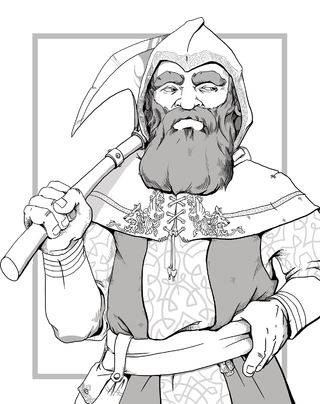
A dwarf, in the Dungeons & Dragons (D&D) fantasy roleplaying game, is a humanoid race, one of the primary races available for player characters. The idea for the D&D dwarf comes from the dwarves of European mythologies and J. R. R. Tolkien's novel The Lord of the Rings (1954–1955), and has been used in D&D and its predecessor Chainmail since the early 1970s. Variations from the standard dwarf archetype of a short and stout demihuman are commonly called subraces, of which there are more than a dozen across many different rule sets and campaign settings.
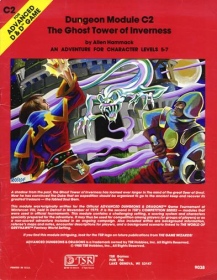
The Ghost Tower of Inverness is an adventure module for the Dungeons & Dragons fantasy roleplaying game, set in the game's World of Greyhawk campaign setting. The module's title refers to an ancient magical tower located in the southern Abbor-Alz Hills. The "C" in the module code represents the first letter in the word "competition," the name of C1 – C6 module series.

Jacob Franklin Mentzer III is an American fantasy author and game designer who worked on early materials for the Dungeons & Dragons (D&D) fantasy role-playing game. He was an employee of TSR, Inc. from 1980 to 1986, spending part of that time as creative advisor to the chairman of the board, Gary Gygax. He also founded the Role-Playing Games Association (RPGA) during his time with TSR.
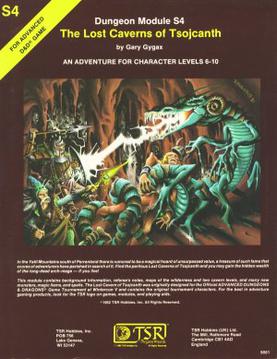
The Lost Caverns of Tsojcanth is an adventure module for the Dungeons & Dragons fantasy role-playing game. It was written by Gary Gygax and published by TSR in 1982 for the first edition Advanced Dungeons & Dragons (AD&D) rules. The 64-page adventure bears the code "S4" and is set in the Greyhawk campaign setting. It is divided into two parts, a 32-page adventure, and a 32-page booklet of monsters and magic items. The plot involves the player characters investigating rumors of lost treasure. After traversing a wilderness and two levels of dungeons, the players face Drelnza, the vampiric daughter of long-deceased archmage Iggwilv.
Tritons are a fictional species in the Dungeons & Dragons fantasy role-playing game.
The legion of fictional deities in the World of Greyhawk campaign setting for the Dungeons & Dragons fantasy roleplaying game covers an extensive range of spheres of influence, allowing players to customize the spiritual beliefs and powers of their characters, and as well as giving Dungeon Masters a long list of gods from which to design evil temples and minions. Although the Greyhawk campaign world, when it was merely a home game, started with no specific gods, the value of having deities available for both players and game plot purposes was quickly realized. The number of deities has varied with each version of the campaign world that has been published, but for many years numbered a few dozen. It has only been since 1999 that the number of gods increased dramatically to almost 200, due to the volume of newly published material that was subsequently integrated into the campaign world.
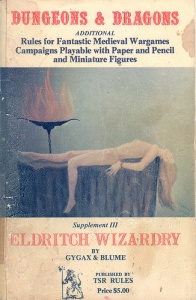
Eldritch Wizardry is a supplementary rulebook by Gary Gygax and Brian Blume, written for the original edition of the Dungeons & Dragons (D&D) fantasy role-playing game, which included a number of significant additions to the core game. Its product designation is TSR 2005.

Dragons of Desolation is the fourth and final module in the first major story arc in the Dungeons & DragonsDragonlance series of game modules. It is one of the fourteen Dragonlance adventures published by TSR between 1984 and 1986. The module is intended for player characters of level 6–8.
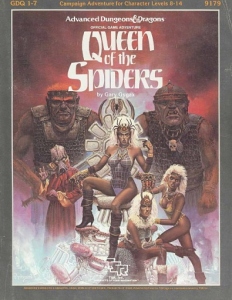
Queen of the Spiders is an adventure module for the Dungeons & Dragons fantasy role-playing game. It was published by TSR, Inc. in 1986 and is a compilation of seven previous related modules, often referred to as a "supermodule." Together, the seven adventures form an integrated campaign that begins in the World of Greyhawk, continues underground into the Underdark, and concludes in the Demonweb Pits, the abyssal lair of the demonic goddess Lolth. The campaign was originally intended for use with the rules from the first edition of Advanced Dungeons & Dragons.
In the Dungeons & Dragons fantasy role-playing game, a magic item is any object that is imbued with magic powers. These items may act on their own or be the tools of the character possessing them. Magic items have been prevalent in the game in every edition and setting, from the original edition in 1974 until the modern fifth edition. In addition to jewels and gold coins, they form part of the treasure that the players often seek in a dungeon. Magic items are generally found in treasure hoards, or recovered from fallen opponents; sometimes, a powerful or important magic item is the object of a quest.

The Book of Artifacts is a supplemental sourcebook to the core rules of the second edition of the Advanced Dungeons & Dragons fantasy role-playing game. This book, published by TSR, Inc. in 1993, details 50 different artifacts, special magic items found within the game at the Dungeon Master's option. The book was designed primarily by David "Zeb" Cook, with some additional design by Rich Baker, Wolfgang Baur, Steve and Glenda Burns, Bill Connors, Dale "Slade" Henson, Colin McComb, Thomas M. Reid, and David Wise. Cover art is by Fred Fields and interior art and icons were designed by Daniel Frazier.

Dungeons & Dragons Immortals Rules, written by Frank Mentzer, is a boxed set for the Dungeons & Dragons (D&D) fantasy role-playing game first published by TSR in 1986 as an expansion to the Basic Set.
The Wand of Orcus is a fictional magical weapon described in various Dungeons & Dragons media. Because of the popularity of Orcus as a villain within the Dungeons & Dragons universe, many different authors have written materials describing artifacts created by or associated with the character. The Wand of Orcus is consistently the most important and most described of these artifacts. Screen Rant has noted that "[t]he weapon that Orcus wields in battle is almost as famous as the demon lord himself". Furthermore, the device has at times been employed in books, games, and other media within the franchise as a thing distinct from Orcus himself, such that adventurers may encounter the wand as a freestanding element of the game or story.

The Dancing Hut of Baba Yaga is an adventure module for the 2nd edition of the Advanced Dungeons & Dragons fantasy role-playing game.

The Rod of Seven Parts is a fantasy novel by Douglas Niles, based on the Dungeons & Dragons role-playing game, published in 1996.











